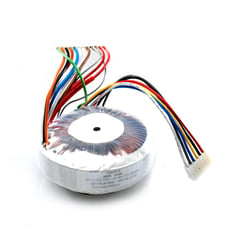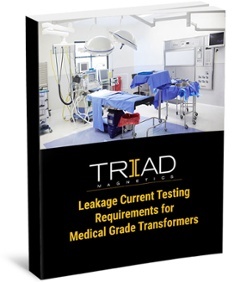Across all types of industries and applications, transformers must meet specific performance and safety guidelines. But medical grade transformers, in particular, are subject to very stringent regulations in order to protect patient safety and well being.

Some of the most important medical transformer standards relate to leakage current — any current that passes through the dielectric insulation. “Leakage current” can refer to currents that are actually physically “leaking” through the insulation, as well as capacitive currents that appear to cross through even the highest-performing insulation.
While it’s best to avoid leakage current altogether no matter the specific application, the results can be disastrous in medical grade machinery and equipment. One of the best ways to minimize leakage current is to use a low leakage current transformer in medical settings.
In a hospital, for instance, a leaking device could cause current to flow through a patient, potentially leading to electric shock. Leaking current can also interfere with crucial monitoring devices such as EKG.
To prevent these risks, original equipment manufacturers (OEMs) providing products and services for the medical industry must carefully consider transformer design and leakage current measurements.
Leakage Current Standards
Underwriters Laboratories (UL) and the International Electrotechnical Commission (IEC) serve as the main regulatory bodies determining minimum safety standards for electronic products, including medical grade transformers.

Appointed by the Occupational Safety and Health Administration (OSHA), UL is the official U.S. regulatory body.
Meanwhile, the IEC, working closely with every nation’s own laboratory, acts as the primary standards body in Europe. Both of these organizations maintain specific standards pertaining to maximum allowable leakage current values.
Working with a low leakage transformer will make it much easier to meet these standards.
Measuring Leakage Current
In the past, leakage current was measured by applying the maximum expected input voltage between the primary and secondary at the power line frequency; the current flowing capacitively between the windings (assuming the return path was through the ground) was measured to determine leakage.
Although this type of leakage is still tested today, it is now considered “earth leakage” and is not suitable for measuring patient leakage currents.
Modern standards and methods necessitate proper transformer energizing before measurement leakage, and now, because of the efficacy of today’s insulating materials, most leakage current is caused by capacitive currents created from the difference in voltage across the insulating barrier.
The Importance of Transformer Testing and Best Practices
Maintaining leakage current testing best practices for medical transformers is critical for ensuring optimal equipment efficiency and patient safety. Reliable testing methods not only allow for more accurate specifications of transformers and the products in which they’re used, but they also help in safeguarding against potential malfunctions and failures.
If a transformer fails to secure UL or IEC certification because of excessive leakage current, the product will have to be completely redesigned, resulting in high costs, lost time, and general stress.
Learn More
 To learn more about leakage current testing to modern standards, download our free eBook, “Leakage Current Testing Requirements for Medical Grade Transformers,” which highlights specific standards and measuring methods. Or, to speak directly with a one of Triad’s experts, contact us today.
To learn more about leakage current testing to modern standards, download our free eBook, “Leakage Current Testing Requirements for Medical Grade Transformers,” which highlights specific standards and measuring methods. Or, to speak directly with a one of Triad’s experts, contact us today.





